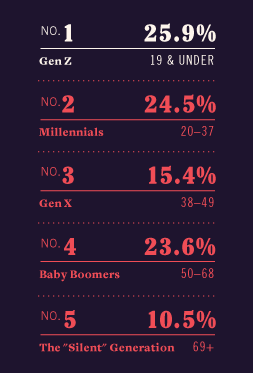
Millennials Are Important, But Watch Out For Gen Z
Did you just update your entire marketing strategy to ensure you were properly focused on the Millennial generation? If so, that’s unfortunate, since it’s now time to move on — or at least expand. Millennials (people aged 20-37) are now only the second largest marketing cohort, making up 24.5% of the population, according to a new study by Sparks & Honey.
Number 1? Generation Z, Millennials’ successors who are now 19 and under. They are almost 26% of the population:

Don’t be fooled by their young age, either: Gen Z is estimated to have over $44 billion of purchasing power. Large companies are starting to take notice, as evidenced by Microsoft’s $2.5 billion purchase of Minecraft and Amazon’s $940 million acquisition of Twitch. This is just the beginning of the rush to reach the first natively digital generation.
As the world determines how to adjust to their different behaviors, here are some important techniques to reach this group effectively:
- Make an impression quickly: Their attention span averages 8 seconds.
- And don’t be verbose: They interact with each other using images (e.g., emoji) much more than previous generations have. Short, so-called “snackable” content is critical to engaging them.
- Reach them on many platforms: They are hyper-connected, using 5 screens to communicate and consume entertainment, compared to just 2 for Millennials.
- Respect their privacy: 25% of 13-to-17-year-olds left Facebook in 2014, many of them for more ephemeral and less public communication platforms like Snapchat, Secret and Whisper.
- Allow them independence: 72% of high school students want to start a business someday, and 61% would rather be an entrepreneur than an employee when they graduate college.
- Make sure they can enjoy themselves at work: 76% wish their hobbies would turn into their jobs, compared to 50% of Millennials.
- Offer them a way to do good: They are socially aware, as 60% of them want to have an impact on the world, compared to 39% of Millennials.
Businesses must be very cognizant of these characteristics and allow critical changes to flourish in their organizations to be able to communicate with this new group of consumers. These changes include but are not limited to:
- New marketing tactics (having a truly authentic, organic voice about what your company stands for and how it will integrate into their lives)
- Extensive use of social networks (be able to reach the audience where and how they live)
- Design adjustments to products (e.g., platform-appropriate presentation)
- Different types of content (e.g., Vines, Instagram videos, Snapchat stories)
- An overall philosophical shift to align with Gen Z (more altruistic and truly respectful of their needs)
It’s not clear what the next cohort will be called (Gen AA?), but we have time to figure that out since Gen Z is just getting started and will only get more powerful.

